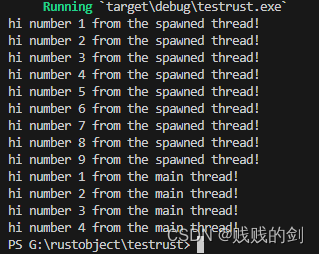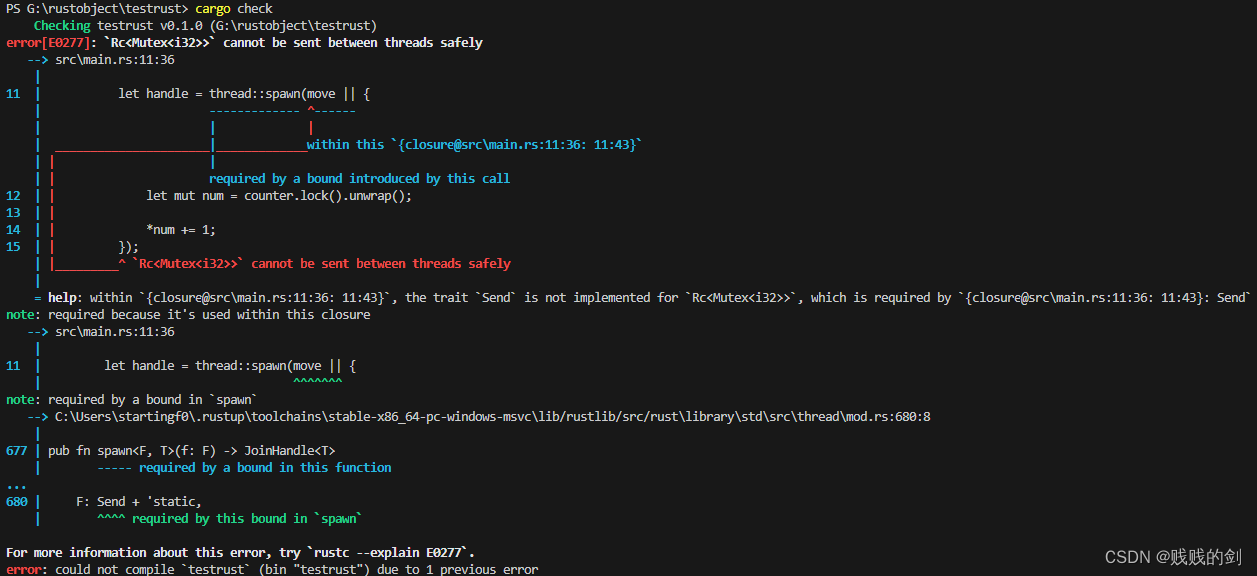目录
- 一、一些概念
- 二、进程和线程
-
- [2.1 概念](#2.1 概念)
- [2.2 多线程导致的问题](#2.2 多线程导致的问题)
- [2.3 使用spawn创建新线程](#2.3 使用spawn创建新线程)
- [2.4 线程与move闭包](#2.4 线程与move闭包)
- 三、消息传递
-
- [3.1 概念](#3.1 概念)
- [3.2 创建通道](#3.2 创建通道)
- [3.3 示例](#3.3 示例)
- [3.4 其它测试](#3.4 其它测试)
- 四、共享状态并发
-
- [4.1 互斥器](#4.1 互斥器)
- [4.2 Mutex的API](#4.2 Mutex的API)
- [4.3 多线程共享Mutex](#4.3 多线程共享Mutex)
-
- 1)在多线程之间共享值;
- 2)多线程和多所有权
- [3) 原子引用计数](#3) 原子引用计数)
- [4)RefCell/Rc与 Mutex/Arc的相似性](#4)RefCell/Rc与 Mutex/Arc的相似性)
- [五、使用Sync和Send Trait的可扩展并发](#五、使用Sync和Send Trait的可扩展并发)
-
- [5.1 send](#5.1 send)
- [5.2 Sync](#5.2 Sync)
一、一些概念
- 并发编程(Concurrent programming):程序的不同部分相互独立运行;
- 并行编译(parallel programming):程序不同部分同时运行;
- 这里将以上两个概念统称为并发,而不做更加细致的区分;
二、进程和线程
2.1 概念
- 进程(process):在大部分现代OS中,已执行的代码运行在一个进程中,OS管理多个进程;
- 线程(Thread):在程序内部同时运行的多个独立部分;
2.2 多线程导致的问题
- 线程是同时运行的,所以无法预先线程的执行顺序,因此导致以下问题:
- 竞争状态(Race conditions):多个线程以不一致的顺序访问数据或资源;
- 死锁(Deadlocks):两个线程相互等待对方所持有的资源;
- 只在某些情况下发生BUG,很难复现和修复;
2.3 使用spawn创建新线程
- 调用
thread::spawn函数并传递一个新线程运行的代码闭包;
rust
use std::thread;
use std::time::Duration;
fn main() {
thread::spawn(|| {
for i in 1..10 {
println!("hi number {} from the spawned thread!", i);
thread::sleep(Duration::from_millis(1));
}
});
for i in 1..5 {
println!("hi number {} from the main thread!", i);
thread::sleep(Duration::from_millis(1));
}
}程序运行结果如下

- 主线程和子线程一起运行,当主线程结束之后无论子线程是否结束,子线程都会被强制结束;
- 使用
thread::spawn的返回值的join()方法可以保证线程执行完成;
rust
fn main() {
let handle = thread::spawn(|| {
for i in 1..10 {
println!("hi number {} from the spawned thread!", i);
thread::sleep(Duration::from_millis(1));
}
});
for i in 1..5 {
println!("hi number {} from the main thread!", i);
thread::sleep(Duration::from_millis(1));
}
handle.join().unwrap();
}- 通过handle的
join方法会阻止当前运行的线程,直到handle所代表的线程运行结束;

- 把join()方法移动到最后一个for之前,像下面这样
rust
fn main(){
......
handle.join().unwrap();
for i in 1..5 {
println!("hi number {} from the main thread!", i);
thread::sleep(Duration::from_millis(1));
}
}则打印如下

- 可见,这是等待子线程运行结束后才会开始运行主线程;
2.4 线程与move闭包
- move闭包通过与
thread::spawn一起使用,它允许在一个线程中使用另一个线程的数据; - 创建新线程时,可以使用move将值的所有权在线程之间进行转移;
rust
use std::thread;
fn main() {
let v = vec![1, 2, 3];
let handle = thread::spawn(move || {
println!("Here's a vector: {:?}", v);
});
// drop(v); //所有权被转移
handle.join().unwrap();
}- 通过move关键字,将变量v的所有权进行转移;
- 转移之后主线程里的v就不能再使用了;
三、消息传递
3.1 概念
- 消息传递(message passing) 是一个日益流行且安全的并发的方式;
- 通道(channel) 是Rust中实现消息传递并发的主要工具;
- 通道由两部分组成:一个发送者(transmitter)和一个接收者(receiver);
3.2 创建通道
- 使用
mpsc::channel函数创建新通道,函数返回一个元组,分别表示发送端和接收端; - mpsc是多个生产者,单个消费者(multiple producer,single consumer)的缩写;
3.3 示例
rust
use std::thread;
use std::sync::mpsc;
fn main() {
let (tx, rx) = mpsc::channel();
thread::spawn(move || {
let val = String::from("hi");
tx.send(val).unwrap();
});
let received = rx.recv().unwrap();
println!("Got: {}", received);
}- 使用
mpsc::channel()创建通道; - 使用move将发送者tx的所有权转移到子线程中;
- 发送端:
- 发送端的send方法用来获取需要放入通道的值;
- send方法返回一个
Result<T, E>类型,这里发送失败时调用unwrap产生panic;
- 接收端:
- 接收端有两个接收方法:recv 和try_recv;
- recv 会阻塞主线程执行直到从通道中接收一个值,返回
Result<T, E>,发送端关闭时收到一个错误; - try_recv 不会阻塞,立即
Result<T, E>;
3.4 其它测试
通道与所有权转移
rust
use std::thread;
use std::sync::mpsc;
fn main() {
let (tx, rx) = mpsc::channel();
thread::spawn(move || {
let val = String::from("hi");
tx.send(val).unwrap();
println!("val is {}", val);
});
let received = rx.recv().unwrap();
println!("Got: {}", received);
}- 代码尝试在发送端的send之后将值打印出来,提示所有权已经发生了移动;

发送多个值并观察接收者在等待
rust
use std::thread;
use std::sync::mpsc;
use std::time::Duration;
fn main() {
let (tx, rx) = mpsc::channel();
thread::spawn(move || {
let vals = vec![
String::from("hi"),
String::from("from"),
String::from("the"),
String::from("thread"),
];
for val in vals {
tx.send(val).unwrap();
thread::sleep(Duration::from_secs(1));
}
});
for received in rx {
println!("Got: {}", received);
}
}- 子线程循环发送一些字符串;
- 主线程不再显式调用recv函数,而是将rx当作迭代器使用,循环输出接收到的值;
- 主线程的for循环里没有任何暂停的代码,因此它一直在等待从子线程发送的值;
通过克隆创建多个发送者
rust
use std::thread;
use std::sync::mpsc;
use std::time::Duration;
fn main() {
let (tx, rx) = mpsc::channel();
let tx1 = tx.clone();
thread::spawn(move || {
let vals = vec![
String::from("tx1: hi"),
String::from("tx1: from"),
String::from("tx1: the"),
String::from("tx1: thread"),
];
for val in vals {
tx1.send(val).unwrap();
thread::sleep(Duration::from_secs(1));
}
});
thread::spawn(move || {
let vals = vec![
String::from("tx: more"),
String::from("tx: messages"),
String::from("tx: for"),
String::from("tx: you"),
];
for val in vals {
tx.send(val).unwrap();
thread::sleep(Duration::from_secs(1));
}
});
for received in rx {
println!("Got: {}", received);
}
}- 发送之前调用发送端的
clone方法再创建一个发送端; - 两个发送端者往通道里写入,接收端接收,从下面的结果中可以看到两个发送端的数据被交替接收到了;

四、共享状态并发
- Rust支持通过共享状态实现并发;
- 通道类似于单所有权:一旦将值传送到通道中,就无法再次使用这个值;
- 共享内存并发类似多所有权:多个线程可以同时访问同一块内存;
4.1 互斥器
- 互斥器(mutex)只允许一个线程访问某些数据;
- 使用互斥器:
- 在使用数据之前尝试获取互斥锁;
- 处理完被互斥器所保护的数据之后,必须解锁;
4.2 Mutex的API
- 通过
Mutex::new创建Mutex<T>,这是一个智能指针; - 使用
lock方法获取锁,此方法会阻塞当前线程,直接获取锁为止; - 当拥有锁的线程panic了,
lock会失败; lock的返回值是MutexGuard的智能指针,离开作用域时,自动解锁;
rust
use std::sync::Mutex;
fn main() {
let m = Mutex::new(5);
{
let mut num = m.lock().unwrap();
*num = 6;
}
println!("m = {:?}", m);
}- 调用
Mutex::new创建一个Mutex,其中的5是要保护的数据; - 调用
lock获取锁,使用 unwrap()处理panic的情况; - 离开内部作用域后自动解锁;

4.3 多线程共享Mutex
1)在多线程之间共享值;
rust
use std::sync::Mutex;
use std::thread;
fn main() {
let counter = Mutex::new(0);
let mut handles = vec![];
for _ in 0..10 {
let handle = thread::spawn(move || {
let mut num = counter.lock().unwrap();
*num += 1;
});
handles.push(handle);
}
for handle in handles {
handle.join().unwrap();
}
println!("Result: {}", *counter.lock().unwrap());
}- 创建一个要保护的计数器counter,初始值是0和空的Vector;
- 创建10个子线程,将每个线程句柄放到Vector中,线程内部获取要保护的值并加1;
- 离开子线程作用域后自动释放锁资源;
- 最后在主线程中打印counter的值;

- value moved into closure here, in previous iteration of loop表示所有权已经在上一次循环中移动过了,因此这里不能再移动;
2)多线程和多所有权
Rc<T>智能指针可以拥有多所有者;- 将
Mutex<T>封装进Rc<T>;
rust
use std::rc::Rc;
use std::sync::Mutex;
use std::thread;
fn main() {
let counter = Rc::new(Mutex::new(0));
let mut handles = vec![];
for _ in 0..10 {
let counter = Rc::clone(&counter);
let handle = thread::spawn(move || {
let mut num = counter.lock().unwrap();
*num += 1;
});
handles.push(handle);
}
for handle in handles {
handle.join().unwrap();
}
println!("Result: {}", *counter.lock().unwrap());
}编译报错

- 编译器提示:线程里
Rc<T>不能被安全的发送; - 之前提过
Rc<T>只能用在单线程中; - 多线程中使用原子引用计数;
3) 原子引用计数
- 原子引用计数
Arc<T>是一个类似Rc<T>并可以安全的用于并发环境的类型; - 封装在
std::sync::atomic中; Arc<T>与Rc<T>的API相同;
rust
use std::sync::{Mutex, Arc};
use std::thread;
fn main() {
let counter = Arc::new(Mutex::new(0));
let mut handles = vec![];
for _ in 0..10 {
let counter = Arc::clone(&counter);
let handle = thread::spawn(move || {
let mut num = counter.lock().unwrap();
*num += 1;
});
handles.push(handle);
}
for handle in handles {
handle.join().unwrap();
}
println!("Result: {}", *counter.lock().unwrap());
}- 输出正确结果:10
4)RefCell/Rc与 Mutex/Arc的相似性
- 和Cell家族一样,
Mutex<T>提供了内部可变性; - 可以使用
RefCell<T>改变Rc<T>里的内容; - 可以使用
Mutex<T>改变Arc<T>里的内容; Mutex<T>有死锁风险 ;
五、使用Sync和Send Trait的可扩展并发
- Rust语言本身的并发性较少,目前的并发特性都来自于标准库;
- 无需局限于标准库的并发,可以自己实现;
- Rust语言中有两个并发概念:
std::marker::Sync和std::marker::Send两个trait;
5.1 send
- Send标记的trait表明所有权可以在线程间传递;
- 几乎所有的Rust类型都是Send的;
Rc<T>没有实现Send,它只适合单线程;- 任何完全由Send类型组成的类型也被标记为Send;
- 除了原始指针之外,几乎所有的基础类型都是Send;
5.2 Sync
- Sync标记的trait可以安全的被多个线程引用;
- 如果T是Sync,那么&T就是Send,这意味着引用可以安全的发送到另一个线程;
- 基础类型都是Sync
- 完全由Sync类型组成的类型也是Sync,但
Rc<T>不是Sync的,RefCell<T>和Cell<T>家族也不是Sync的;
手动实现Send和Sync是不安全的